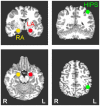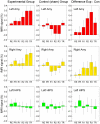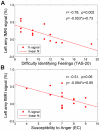Self-regulation of amygdala activation using real-time FMRI neurofeedback
- PMID: 21931738
- PMCID: PMC3169601
- DOI: 10.1371/journal.pone.0024522
Self-regulation of amygdala activation using real-time FMRI neurofeedback
Abstract
Real-time functional magnetic resonance imaging (rtfMRI) with neurofeedback allows investigation of human brain neuroplastic changes that arise as subjects learn to modulate neurophysiological function using real-time feedback regarding their own hemodynamic responses to stimuli. We investigated the feasibility of training healthy humans to self-regulate the hemodynamic activity of the amygdala, which plays major roles in emotional processing. Participants in the experimental group were provided with ongoing information about the blood oxygen level dependent (BOLD) activity in the left amygdala (LA) and were instructed to raise the BOLD rtfMRI signal by contemplating positive autobiographical memories. A control group was assigned the same task but was instead provided with sham feedback from the left horizontal segment of the intraparietal sulcus (HIPS) region. In the LA, we found a significant BOLD signal increase due to rtfMRI neurofeedback training in the experimental group versus the control group. This effect persisted during the Transfer run without neurofeedback. For the individual subjects in the experimental group the training effect on the LA BOLD activity correlated inversely with scores on the Difficulty Identifying Feelings subscale of the Toronto Alexithymia Scale. The whole brain data analysis revealed significant differences for Happy Memories versus Rest condition between the experimental and control groups. Functional connectivity analysis of the amygdala network revealed significant widespread correlations in a fronto-temporo-limbic network. Additionally, we identified six regions--right medial frontal polar cortex, bilateral dorsomedial prefrontal cortex, left anterior cingulate cortex, and bilateral superior frontal gyrus--where the functional connectivity with the LA increased significantly across the rtfMRI neurofeedback runs and the Transfer run. The findings demonstrate that healthy subjects can learn to regulate their amygdala activation using rtfMRI neurofeedback, suggesting possible applications of rtfMRI neurofeedback training in the treatment of patients with neuropsychiatric disorders.
Conflict of interest statement
Figures









References
-
- Cox RW, Jesmanowicz A, Hyde JS. Real-time functional magnetic resonance imaging. Magn Reson Med. 1995;33(2):230–236. - PubMed
-
- deCharms RC. Applications of real-time fMRI. Nat Rev Neurosci. 2008;9(9):720–729. - PubMed
-
- Sterman MB. Basic concepts and clinical findings in the treatment of seizure disorders with EEG operant conditioning. Clin Electroencephalogr. 2000;31(1):45–55. - PubMed
-
- Nowlis DP, Kamiya J. The control of electroencephalographic alpha rhythms through auditory feedback and the associated mental activity. Psychophysiology. 1970;6(4):476–484. - PubMed
-
- Levesque J, Beauregard M, Mensour B. Effect of neurofeedback training on the neural substrates of selective attention in children with attention-deficit/hyperactivity disorder: a functional magnetic resonance imaging study. Neurosci Lett. 2006;394:216–224. - PubMed
Publication types
MeSH terms
Substances
LinkOut - more resources
Full Text Sources
Other Literature Sources
Medical

